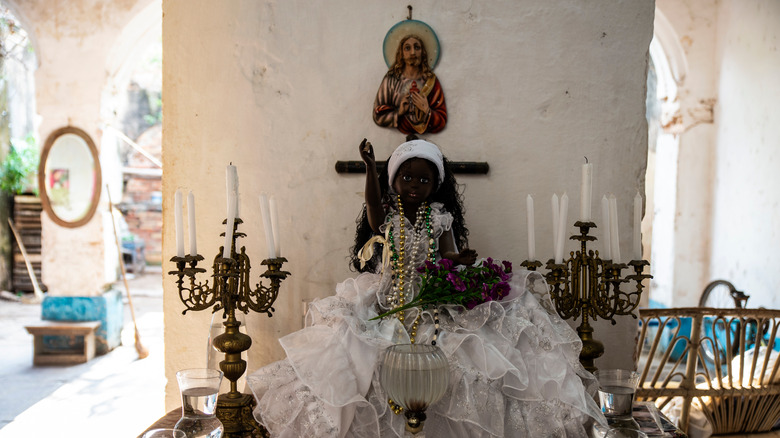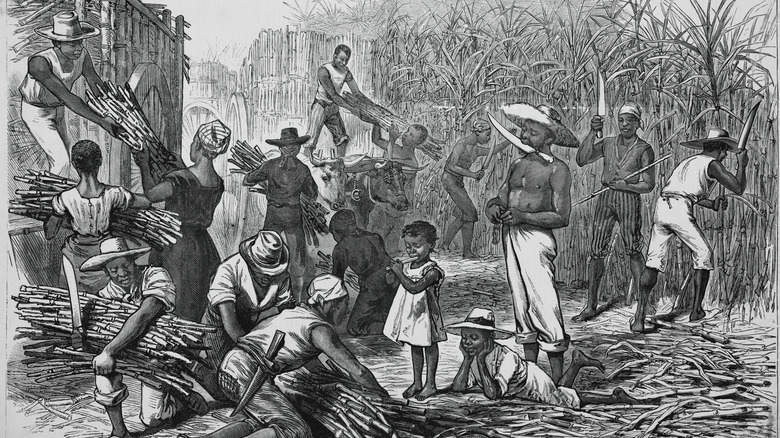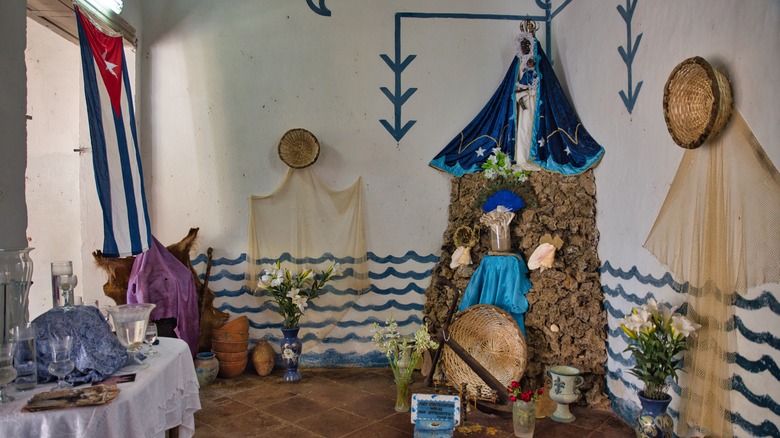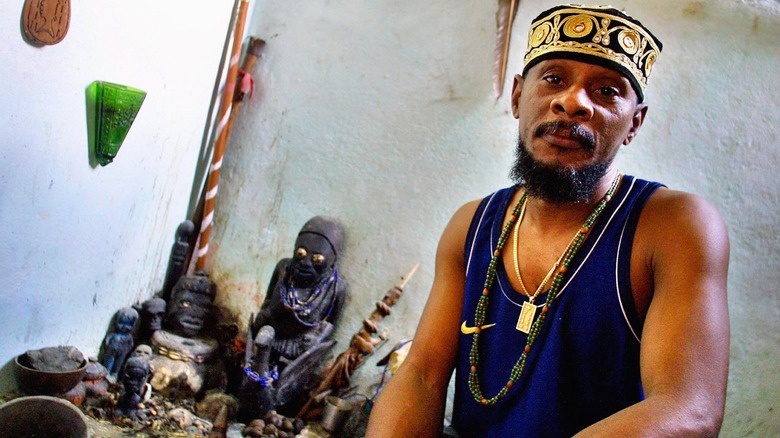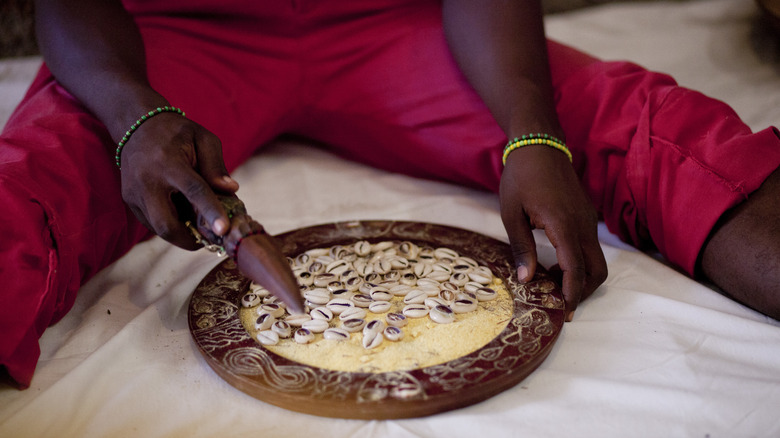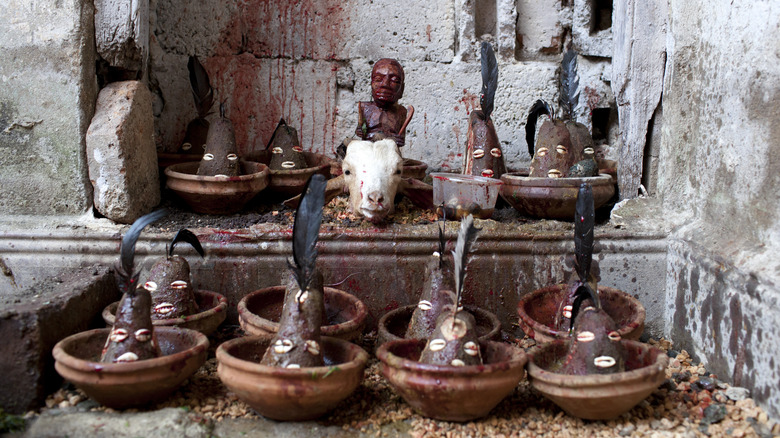What Is Santeria And What Do Followers Believe?
Similar to Vodou in the U.S. and Caribbean, Santería was born out of the slave trade, a rehashing of beliefs taken from African religion and reworked in a new context. Santería developed in Cuba under the watchful eyes of the Catholic Church, where adherents were heavily impacted by Christian ideas.
The word Santería literally means "the way of the saints" because practitioners regard the African Yoruban divinities (the Orishas) as being synonymous with certain Christian figures. Due to the syncretic nature of the faith, today many Cubans both attend Church and practice Santería. Although practitioners were once forced to keep their faith, in modern times the faith is practiced openly, and the esoteric allure of Santería rituals is often used to earn money from tourists. According to Reuters, seven in 10 Cubans follow the religion today.
Interaction with the divine is a big part of the Santería faith, which is complex and involves many ceremonies and rituals. Followers strongly believe that the Orisha can affect our lives on earth and can be persuaded to help us. Sacrifice, divination, dancing, and singing are all crucial to followers of the faith.
Santeria and the slave trade
Scattered across Nigeria and other parts of West Africa, the Yoruba people are united by a series of shared beliefs and cultural practices, as well as a common language. Many Yoruba were forced into slavery during colonial times, and they brought their beliefs with them to the Americas. According to Mary Ann Clark's "Santería," most Yoruba were delivered to Cuba in the 1800s, made to toil on plantations during the island's sugar boom. Although life was difficult for enslaved people, the colonists did permit them to meet and socialize at cabildos. At these clubs, various African traditions and religious practices were able to continue. Following Cuban independence, the cabildos were abolished and a crackdown began on indigenous beliefs.
It was in this fraught that Santería was born. Various Yoruban beliefs merged with each other and merged with Catholicism. Today, baptism is mandatory for Santería priests and priestesses, and shrines to Catholic Saints, and even the Virgin Mary are treated as Orisha shrines despite some discomfort among the Catholic clergy.
It remains unclear to what extent the merging of Yoruba beliefs and Catholic ideas was for safety reasons and to what extent people simply believed it. Either way, today many people argue wholeheartedly for the "syncretic" view that the two traditions are simply different attempts to describe the same divinities.
Old gods, new gods
The Orishas that the Yoruba worship in Africa typically vary depending on where the worshipper was born and whose rites they have been introduced to (via Migene Gonzalez-Wippler, "Santería: The Religion, Rites, Faith, Magic"). Practitioners of Santería, however, acknowledge all the Orisha as part of their faith and identify them with specific Christian figures.
According to Havana Times Shango (the Yoruba Thunder God) is believed to be synonymous with Saint Barbara. This is because Shango once dressed up as a woman (the deity Oya) in order to hide from his enemies, and Saint Barbara is known for her great courage. Both are associated with the colors red and white, and both are depicted holding a weapon.
In a similar fashion, Our Lady of Charity (the Virgin Mary), is identified as the river God Ochún. Jesus Christ is usually not identified as an Orisha at all — but with a more powerful divinity still — Olofi, the God who takes charge of the lesser deities. All the Orishas are manifestations of the one true god, the Olodumare.
Ashe (life force) and destiny
Belief in ashe — life force — is central to Santería, and informs everything practitioners do. Ashe literally means "so be it" in the Yoruba language and ashe energy is connected to personal destiny and spiritual fulfillment (via Migene Gonzalez-Wippler, "Santería: The Religion, Rites, Faith, Magic"). The true god, the Olodumare used this force to create all life and the universe itself.
The divine Orishas can give humans extra ashe for various purposes. Ashe is the energy of everything in the universe, and the initiated can manipulate it through religious ritual and spiritual practice to some degree, depending on the knowledge level of the practitioner (via Mary Ann Clark, "Santería"). All followers of the religion are ranked by their level of initiation and expertise, from recent initiates to high priests.
Ashe is neither good nor bad but adherents should seek balance and alignment with their own personal ashe to fulfill their spiritual destiny. By demonstrating Iwa Pele ("good character"), we can also change the energy around us in a positive way.
Divination
For followers of Santería, their relationship with the divine Orishas can be quite personal. Divination is central to Santería, helping devotees to communicate with the divine, make decisions, and answer burning personal questions. There are two major forms of fortune telling in Santería: Diloggun — which involves casting cowry shells, and Obi, the interpretation of coconut shards.
Diloggun reading is quite complex, and only those who have been fully initiated are allowed to cast them (via Migene Gonzalez-Wippler, "Santería: The Religion, Rites, Faith, Magic"). A reader will normally throw 16 shells in a reading, and depending on whether they lie face up or down, they interpret the message being received. The mouthlike shells are thought to represent the mouths of the divine Orishas who deliver the message, and there are 256 possible combinations of shells, leaving great room for nuanced messages. The igbo (divination aids) are also part of the diviner's tool kit, and they assist the reader with their interpretation of the shells. The igbo include a stone, a seashell, a powdered eggshell, a doll's head, and a piece of animal vertebra.
Obi is a simpler system, used to determine whether a sacrifice or offering has pleased the Orishas. Four coconut rinds are thrown on the floor and their positions are used to anticipate the gods' wishes.
Offerings and sacrifices
Offerings are used for several reasons in Santería: to respect ancestors, to honor gods, and to mark key life events. The divine Orishas are powerful beings but they still need energy (ashe, life force) to survive. To keep them fed and watered, gifts (ebbos) must be offered.
Latino Life Magazine notes that although they may intrigue outsiders, blood sacrifices are actually fairly rare compared to other offerings. Blood is a powerful gift, not to be used lightly. Gifts of food, drink, flowers, and candles are all normal offerings, and libations are regularly poured to remember the dead and honor ancestors from ages past. Music and dancing (especially drumming) often accompany ritual offerings and count as an offering itself — embuing the Orishas with additional life force energy.
Animals are ritually slaughtered when it is most required or after ceremonies and important events such as weddings and births. The blood is drained away for the Orishas and the meat is eaten by the human beings.
